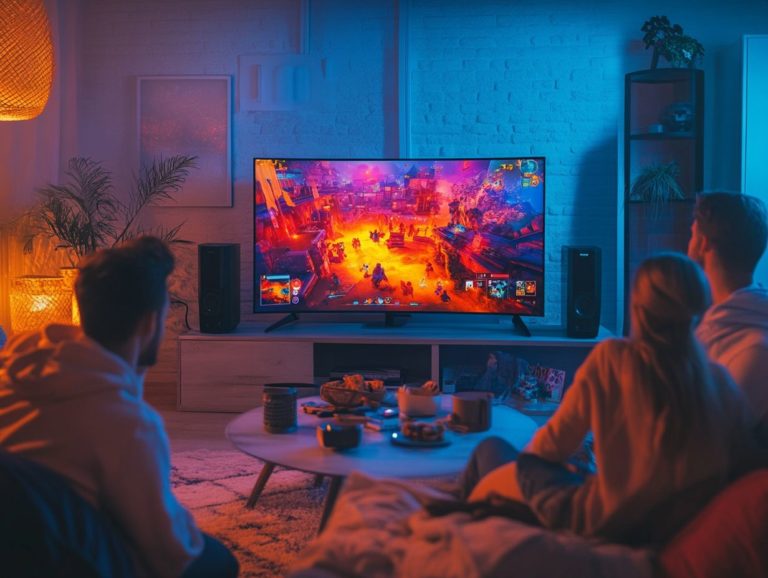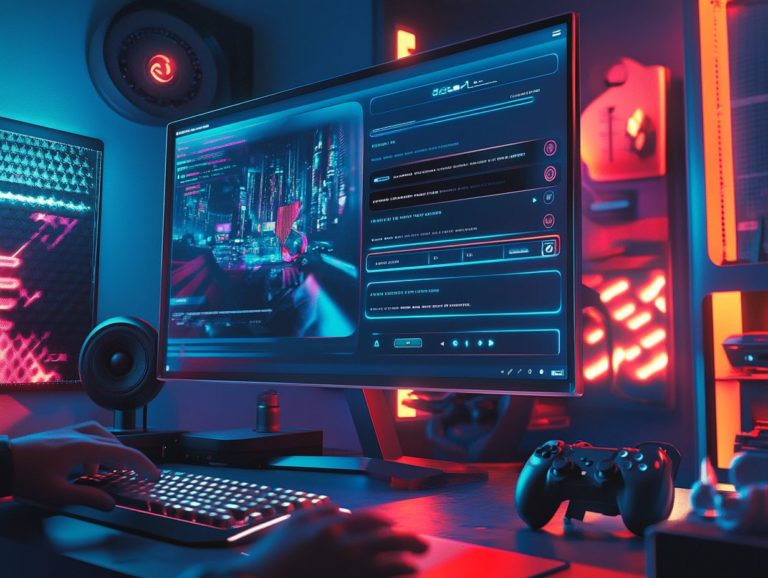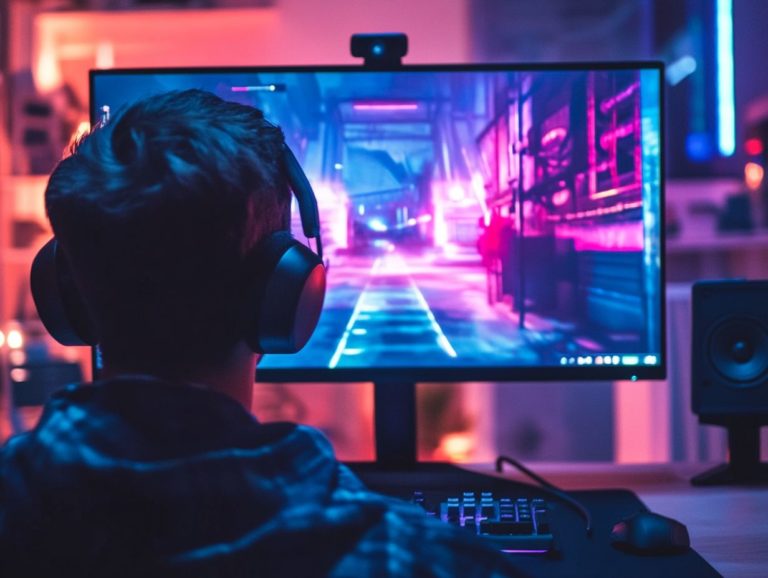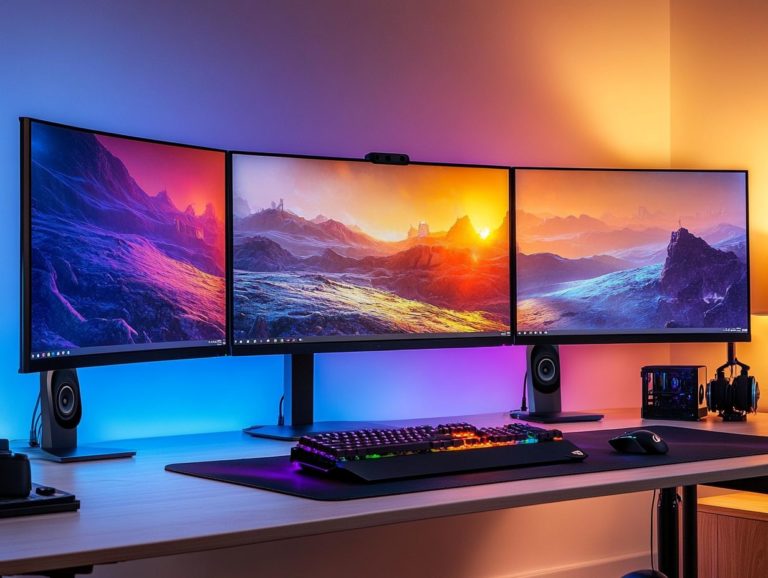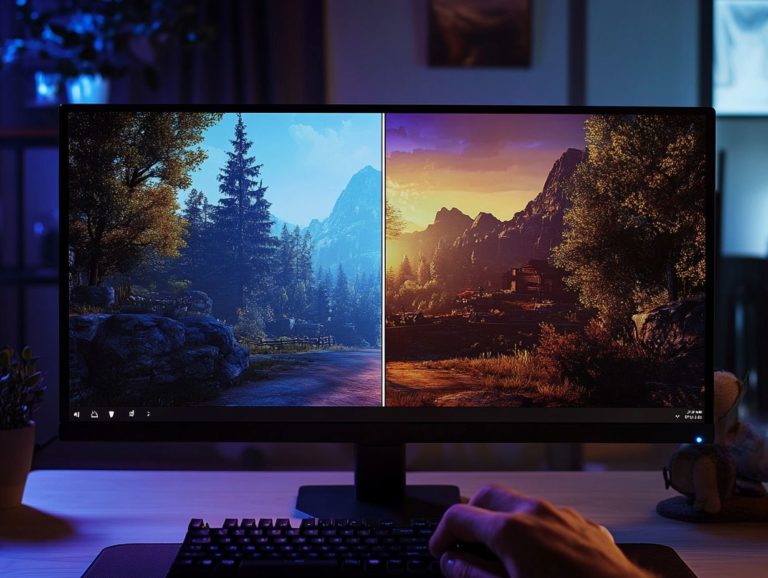how refresh rate impacts gaming performance
In the realm of gaming, the refresh rate of your monitor can greatly affect your enjoyment. A higher refresh rate means a smoother experience without frustration.
Understanding refresh rate is key to improving your gaming performance. This article explores what refresh rate means, how it affects input lag and visual quality, and what to consider when choosing the best refresh rate for your setup.
We ll also debunk common misconceptions that can cloud your judgment. This knowledge will help you make informed decisions and elevate your gaming experience!
Prepare to dive in and unlock your gameplay’s full potential!
Contents
- Key Takeaways:
- Understanding Refresh Rate
- How Refresh Rate Affects Gaming Performance
- Factors to Consider When Choosing a Refresh Rate
- Optimizing Refresh Rate for Gaming
- Common Misconceptions About Refresh Rate and Gaming
- Frequently Asked Questions
- What is refresh rate and how does it impact gaming performance?
- What is the standard refresh rate for gaming monitors?
- How does a higher refresh rate benefit gaming performance?
- Does a higher refresh rate always equal better gaming performance?
- Can a higher refresh rate cause motion sickness while gaming?
- Is a higher refresh rate worth the extra cost for gaming performance?
Key Takeaways:

A higher refresh rate means lower input lag and quicker response time for better gaming performance!
Enjoy smoother gameplay and clearer visuals, making your gaming more immersive.
Consider your hardware and personal preferences when choosing the right refresh rate.
Understanding Refresh Rate
Understanding refresh rate is essential for optimizing your gaming setup. Monitors with higher refresh rates, like 144Hz and 240Hz, revolutionize PC gaming.
These advancements enable smoother gameplay and reduce visual glitches.
With better insight into refresh rate, you can make choices that align with your hardware and performance needs. This paves the way for a superior competitive gaming experience.
How Refresh Rate Affects Gaming Performance
The refresh rate significantly impacts your gaming performance, as it affects input lag, response time, and the smoothness of motion during gameplay. For a deeper understanding, check out the refresh rate explained: a gamer’s guide.
In competitive gaming, these factors are critical to your success!
Input Lag and Response Time
Input lag and response time are crucial metrics for gaming. They determine how quickly your monitor displays commands from your keyboard or mouse.
Input lag is the delay before you see your actions reflected on screen.
Response time indicates how quickly a pixel changes color, measured in milliseconds.
Choosing high refresh rates, such as 144Hz or 240Hz, minimizes input lag and response time. This results in smoother animations and more accurate inputs.
In fast-paced games, lower lag and quicker response times can be the difference between victory and defeat! This dramatically enhances your gaming experience.
Smoothness and Visual Quality
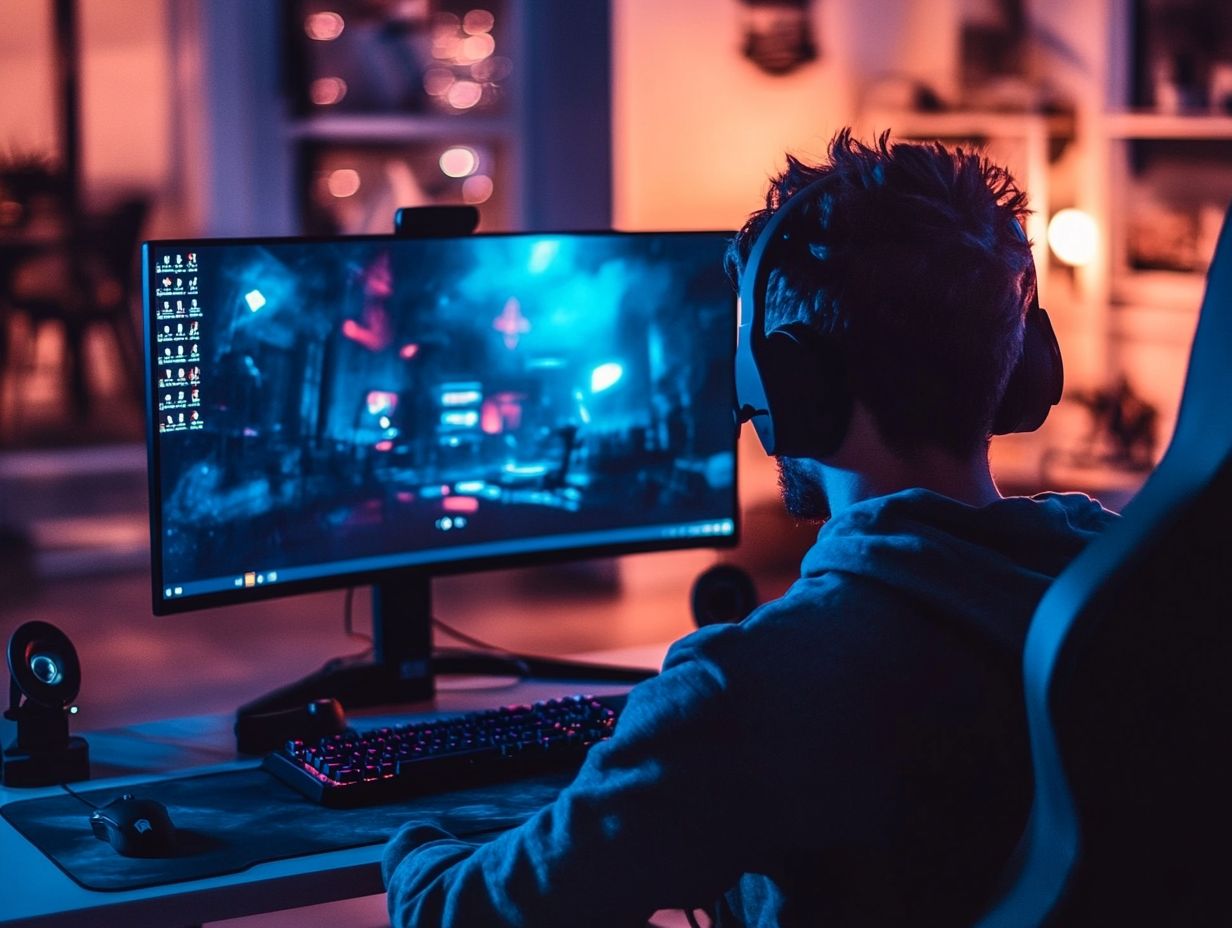
The smoothness of your gameplay and visual quality greatly depend on your monitor’s refresh rate. A higher refresh rate reduces motion blur and sharpens motion resolution.
This smoothness is vital in fast-paced games like “Call of Duty” or “Fortnite,” where rapid movements can overwhelm standard setups.
When your gaming system’s frame rate syncs with a high refresh rate, you enjoy incredibly smooth visuals!
For instance, a refresh rate of 144Hz can display up to 144 frames per second, giving you an edge during critical moments.
High refresh rates improve your control responsiveness and minimize input lag, ensuring your in-game actions align more accurately with your intentions!
Factors to Consider When Choosing a Refresh Rate
When selecting a refresh rate, consider your hardware capabilities, gaming preferences, and the monitor’s specifications. These factors significantly influence your gaming experience!
Hardware Capabilities
Understanding your hardware capabilities is essential for optimizing refresh rates. Both your GPU and CPU play pivotal roles in how effectively your gaming monitor performs especially when you’re aiming for exhilarating higher refresh rates like 144Hz and 240Hz.
To truly harness the power of these impressive refresh rates, you need a robust graphics processing unit (GPU) that can render frames swiftly. This ensures a seamless and fluid gaming experience. Pair that with a powerful CPU, which handles game logic, stability, and responsiveness, freeing up the GPU to focus on delivering stunning graphics.
For example, a combination of an NVIDIA GeForce RTX 3060 and an AMD Ryzen 5 5600X can provide spectacular performance in titles that demand high frame rates.
Monitors like the ASUS ROG Swift PG259QN or the Acer Predator XN253QX stand out as excellent choices. They are carefully designed for gamers who crave high refresh rates and low response times, giving you that competitive edge in gameplay.
Gaming Preferences
Your gaming preferences significantly impact your choice of refresh rate. Whether you lean towards competitive play or relaxed gaming sessions, different titles demand various performance benchmarks.
If you find yourself immersed in fast-paced shooters like ‘Call of Duty’ or ‘Overwatch,’ you re likely to gravitate towards higher refresh rates think 144Hz or even 240Hz. This choice grants you that coveted competitive edge, ensuring every movement feels smooth and responsive.
Conversely, if your heart lies with immersive role-playing games such as ‘The Witcher 3,’ you might prioritize stunning graphics and captivating storytelling over rapid refresh rates. In this case, you may opt for a more modest 60Hz.
This spectrum of gaming styles shapes the technical specifications you pursue and profoundly influences your overall gaming experience. It underscores how your refresh rate decisions are intricately linked to gameplay dynamics and your personal gaming ambitions.
Optimizing Refresh Rate for Gaming

Optimizing the refresh rate for gaming requires you to fine-tune settings and configurations across both your monitor and gaming system. This meticulous adjustment is essential for achieving peak performance and exceptional responsiveness, elevating your gaming experience to new heights.
Adjusting Settings and Configurations
Adjusting the settings and configurations on your gaming monitor can truly elevate your gaming experience. Features like adaptive sync help match the refresh rate of your monitor with the frame rate of your game, reducing lag and tearing.
By exploring the specific settings on your monitor, such as tweaking the refresh rate directly in its menu, you can achieve that smooth visual experience you ve been craving. Enabling features like FreeSync or G-Sync creates seamless synchronization between your monitor and graphics card, allowing for a dynamic refresh rate that effortlessly adapts to your game s frame rate.
Don t overlook system-level configurations either. Updating your graphics drivers and fine-tuning in-game settings are critical for maximizing performance. Together, these enhancements create a more immersive and responsive gaming environment, significantly boosting your overall enjoyment.
Common Misconceptions About Refresh Rate and Gaming
You might encounter a host of misconceptions surrounding refresh rate and its influence on gaming performance. These misunderstandings often cloud the relationship between refresh rates, screen tearing, and visual artifacting.
Such misconceptions leave many gamers with a skewed perspective on what truly matters for an optimal gaming experience.
Ready to boost your gaming performance? Let’s dive in!
Debunking Myths and Clarifying Facts
Debunking myths surrounding refresh rates can illuminate key facts that significantly influence your gaming performance. This helps you grasp the interaction between refresh rates and FPS monitoring within the game s mechanics.
Many gamers mistakenly equate higher refresh rates with superior performance. They believe that simply switching to a 144Hz monitor guarantees smoother gameplay. In reality, the visual fluidity you experience hinges greatly on the frames per second (FPS) your game can actually produce.
Take, for example, a 240Hz monitor. It can showcase up to 240 frames per second. However, if your game’s FPS is capped at 60, that monitor is essentially underperforming. Technologies like G-Sync and FreeSync help reduce screen tearing, which happens when the display shows different frames at the same time, ensuring a seamless gaming experience regardless of the refresh rates in play.
Real-world testing reveals that while a higher refresh rate can bolster performance for competitive players, the difference becomes less significant for casual gamers. Understanding this is crucial for an amazing gaming experience!
Frequently Asked Questions

What is refresh rate and how does it impact gaming performance?
Refresh rate is the number of times per second that a display updates its image. It impacts gaming performance by determining how smooth and responsive the gameplay appears on screen.
What is the standard refresh rate for gaming monitors?
The standard refresh rate for gaming monitors is 60Hz, meaning the screen updates 60 times per second. However, some gaming monitors have higher refresh rates of 120Hz or even 240Hz.
How does a higher refresh rate benefit gaming performance?
Higher refresh rates result in smoother and more fluid motion on screen. This makes gameplay feel more responsive and reduces motion blur, providing a competitive advantage in fast-paced games.
Does a higher refresh rate always equal better gaming performance?
No, a higher refresh rate does not guarantee better gaming performance. It also depends on the hardware capabilities of your computer and the game’s frame rate. If your hardware cannot keep up, the higher refresh rate may not make much of a difference.
Can a higher refresh rate cause motion sickness while gaming?
In some cases, a higher refresh rate can cause motion sickness in individuals who are sensitive to it. The faster screen updates can lead to a disconnect between what the eyes see and what the body feels. It is recommended to try out different refresh rates to find the one that works best for you.
Is a higher refresh rate worth the extra cost for gaming performance?
It ultimately depends on personal preference and budget. If you are a competitive gamer and can afford it, a higher refresh rate can provide a smoother and more responsive gaming experience. However, if you are on a tight budget, a standard 60Hz monitor can still provide decent gaming performance.

